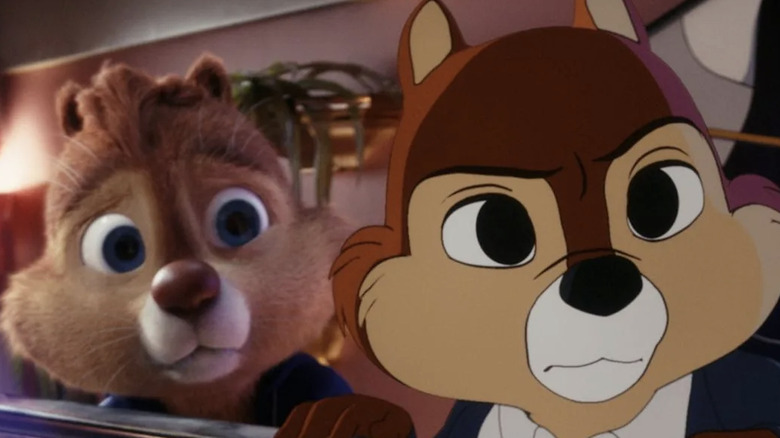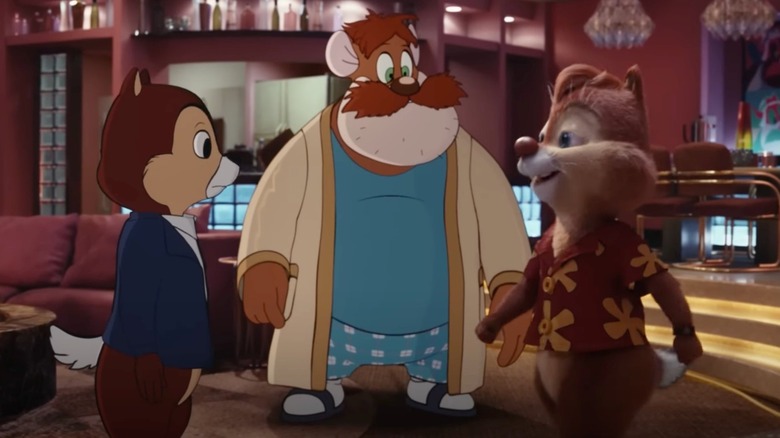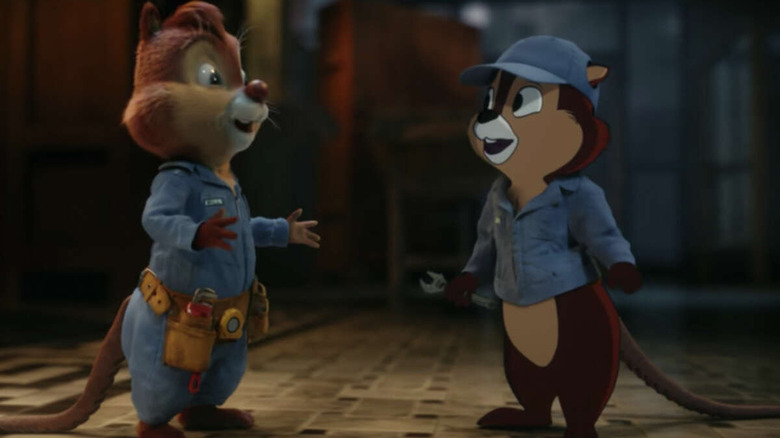Chip 'N Dale: Rescue Rangers Review: Tooning Out
- A "Roger Rabbit"-like animation hybrid, the movie's strength is in its random cartoon cameos.
- The film treats its plot like a chore
- Mulaney is a vanilla voiceover actor
- Cliches abound in the story developments
Every comedy falls into one of three categories: the duds, the nose breathers, and the laugh-out-louds. There are far too few of the latter, and most sadly fall between the first two. Now comes "Chip 'n Dale: Rescue Rangers," a not-quite reboot that might just be the most nose-breathing movie of all time; there's a ton that will make you exhale in bemused recognition, but actual, tangible laughs? The film's ultimate mystery might be why it never quite gets there.
At its best, the Disney+-premiering film is a reminder of all the reasons they should have made a "Who Framed Roger Rabbit?" sequel; at its worst, it's a reminder of why we should be thankful they never did. The film even has a Roger Rabbit cameo — in fact, a cameo from nearly every animation franchise you could think to name, regardless of studio — but in the end, it's a lot of distraction with little depth.
The ostensible plot is a base soup of the Robert Zemeckis classic, sprinkled liberally with "BoJack Horseman," a dash of "Lego Movie"/"Wreck-It Ralph"/"Space Jam: A New Legacy"/"Ready Player One"-crossover randomness, and peppered with every "getting the band back together" cliche since the days of "The Blues Brothers" and "The Muppet Movie." In the early '80s, we're told, Chip (John Mulaney) and Dale (Andy Samberg) were two hungry young actor/writers who came up together, getting their big break in the form of "Rescue Rangers," the very real 1989-1990 animated series that aired afternoons on the Disney Channel. Like any good "Behind the Music" tale, their success eventually tore them apart, with Dale's head getting a bit too big and Chip coming to resent him for it.
Flash-forward to modern day, still in a "Roger Rabbit"-like world where humans and toons co-exist. Dale clings to his faded acting hopes, getting CG (not so plastic) surgery, while Chip has settled into a boring 9-to-5 job. The two haven't spoken in years when they are suddenly brought together by old friend Monterey Jack (Eric Bana), the mustachioed mouse who was a colorful supporting star in their '80s series and has now developed a nasty, expensive habit for black market ... cheese. You can begin to see where the humor is headed, and if films like "The Happytime Murders" and the "Banana Splits" horror film once seemed intriguing, this might similarly remind you that while nihilistic nostalgia makes for a fun trailer, it is a tough tone to sustain for the length of a feature film.
When Jack turns up missing, a sinister plot emerges that has old cartoon characters getting abducted, mutilated, then shipped overseas to appear in copyright-bucking knockoff films. This, of course, forces Chip and ... sorry, 'n ... Dale to reunite and work alongside Gumby-like police Captain Putty (JK Simmons, clearly having a lot of fun) and his underling human detective/Rescue Rangers superfan Ellie Whitfield (KiKi Layne). This is where the plot kicks in, and where it immediately begins to disappoint. The "mystery" is paper-thin; the question of whether Chip 'n Dale will eventually bury the hatchet feels like a pesky mosquito to be swatted away with minimal effort. This is the type of film that contains a scene where someone gets shot, only to pull a badge/flask/Bible/coin from their pocket and miraculously reveal that it had simultaneously stopped the bullet and provided invaluable character insight via the object's symbolic meaning.
That's some stinky cheese
All of this takes a back seat, thankfully, to the film's unabashedly primary goal: Filling nearly every frame with as many animated characters as possible. At first, some are vague: non-specific Transformers, someone who looks like he could be a Pokemon trainer, Simpsons-like extras. Their animation styles hint at which universe they are from, even if they are not named and/or acknowledged by the main characters walking past them. Then, things become as specific as they are random.
Is that MC Skat Cat, dancing with Paula Abdul? Did Robert Crumb's Mr. Natural just make an appearance? Is that bus bench telling us that Butt-Head is now a US Senator? While such moments will have you, as mentioned before, exhaling through your nose in mild bemusement, not a single moment in the film comes within five miles of the inspired lunacy of Daffy and Donald's dueling pianos.
That said, the human-toon-hybrid-world does set "Rescue Rangers" up for some of its best gags. Peter Pan (voiced by Will Arnett), now grown up and overweight, still wears that silly costume and goes by the nefarious street name "Sweet Pete." Seth Rogen's "Bob the Warrior Viking" comes from the Uncanny Valley, a land where uncomfortably real CG characters (think "The Polar Express") walk the streets; at one point, Bob encounters Rogen's other voiceover cartoon characters, and they all erupt in his signature laugh. The most inspired (and unsettling) character in this film, however, might be "Ugly Sonic," a comic convention-haunting has-been whose less-than-favorable social media reception (and those creepy human teeth) had him kicked off a franchise. He's a lot of fun — and may we never, never, ever see him again.
A couple of crazy rascals out to have some fun
Oh, but wait. There's a plot, right? Buried somewhere beneath all those references to Baloo the bear and He-Man's aversion to pants, someone keeps double-crossing Chip 'n Dale, tipping the bad guys off to their whereabouts. Could it be the police captain? Well, no, they say, because that was the plot of several old "Rescue Rangers" cartoons and it just seems too lazy and obvious. Perhaps it's the sycophantic Ellie, but she keeps dropping hints that make it seem like she's the villain, so it can't be that obvious. By the end, you'll just be praying that Snagglepuss, Disco Stu, and Rick and Morty show up together in the Jetsons flying car ... and to its credit, the film makes something like that feel as though it could happen at any moment.
Ultimately, the most glaring shortcoming of "Rescue Rangers," beyond its mandatory-feeling plot, is the voice work by its stars. Samberg is Samberg; if you like his schtick, you'll be delighted to get exactly what Andy Samberg brings to the table. But setting aside writer John Mulaney for a moment (he isn't credited as such here) and looking at him solely as an actor, and one without the benefit of a physical performance, he's little more here than a wet blanket. His Chip is a bundle of insecurities and pessimism, and every time the black-nosed chipmunk opens his mouth, it brings the whole room down.
Obviously, Chip is supposed to be the straight man. But as an early glimpse of Bud Abbott (opposite a toon, rather than Lou Costello) reminds, the straight man is the most important part of any comedy duo. Keep it moving, keep it clever, keep acting flustered and flabbergasted at all the right moments. As a performer, Mulaney doesn't possess anywhere near the droll charm of a Charles Grodin, the quippy quirk of a Jason Bateman, or the hard-boiled playfulness of ... Bob Hoskins alongside Roger Rabbit. Maybe we all need to dust off our old VHS tapes, but was Chip this bland and banal on the original "Rescue Rangers"?
When the smoke clears and the novelty of spotting Stan's dad from "South Park" has subsided, "Chip 'n Dale: Rescue Rangers" leaves you with little more than an admiration for its ambition, an amazement at all the clearance hurdles that must have been leapt, and a lingering exhale of jokes that tickle the viewer, but just can't stick the laughing.


